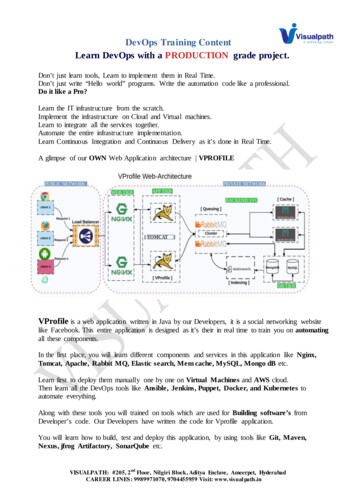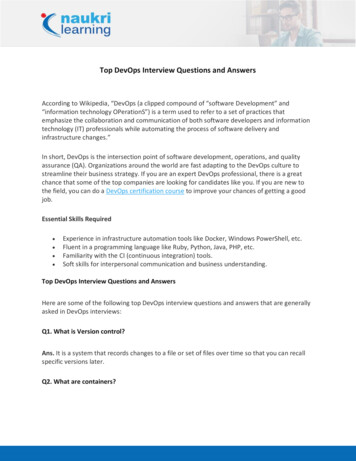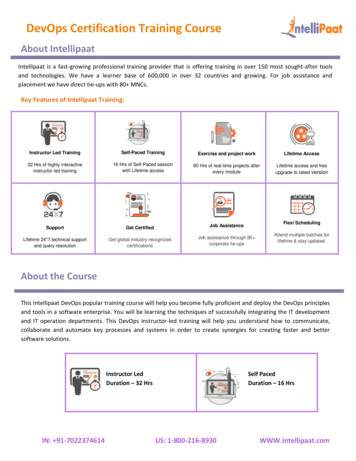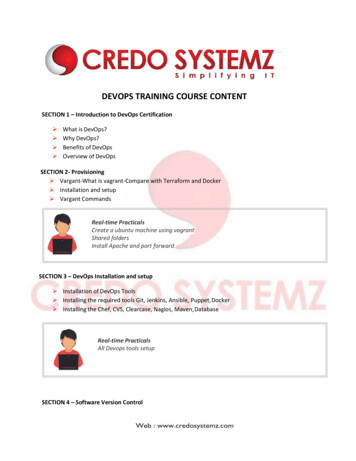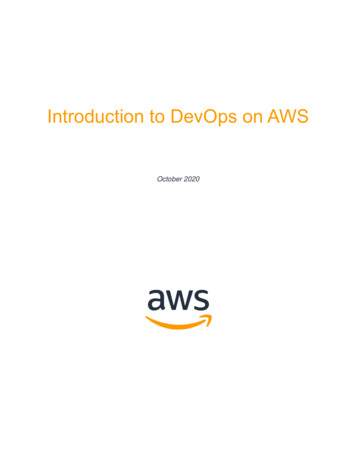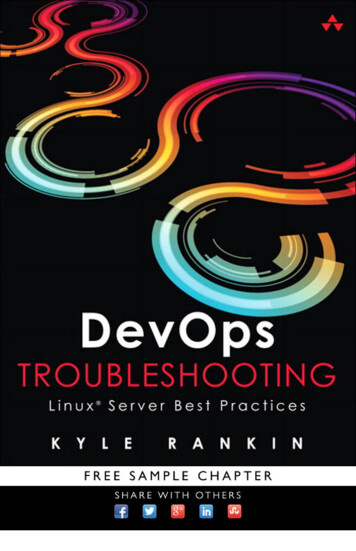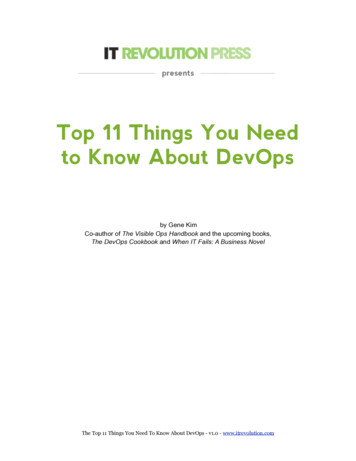
Transcription
presentsTop 11 Things You Needto Know About DevOpsby Gene KimCo-author of The Visible Ops Handbook and the upcoming books,The DevOps Cookbook and When IT Fails: A Business NovelThe Top 11 Things You Need To Know About DevOps - v1.0 - www.itrevolution.com
About the AuthorGene Kim is a multiple award winning CTO, researcher andauthor. He was founder and CTO of Tripwire for 13 years. Hehas written two books, including The Visible Ops Handbook, andis now writing When IT Fails: A Business Novel and The DevOpsCookbook. Gene is a huge fan of IT operations, and how it canenable developers to maximize throughput of features from “codecomplete” to “in production,” without causing chaos anddisruption to the IT environment. He has worked with some ofthe top Internet companies on improving deployment flow andincreasing the rigor around IT operational processes. In 2007,ComputerWorld added Gene to the “40 Innovative IT PeopleUnder The Age Of 40” list, and was given the Outstanding Alumnus Award by the Department ofComputer Sciences at Purdue University for achievement and leadership in the profession.The Top 11 Things You Need To Know About DevOps - v1.0 - www.itrevolution.com
Table of Contents1. What is DevOps and where did it come from?2. How does DevOps differ from Agile?3. How does DevOps differ from ITIL or ITSM?4. How does DevOps fit with VisibleOps?5. What are the unpinning principles of DevOps?6. What are the areas of DevOps patterns?7. What is the value of DevOps?8. How does Infosec and QA integrate into a DevOps work stream?9. My DevOps Favorite Pattern #110. My DevOps Favorite Pattern #211. My DevOps Favorite Pattern #3The Top 11 Things You Need To Know About DevOps - v1.0 - www.itrevolution.com
1. What is DevOps and where did it come from?The term “DevOps” typically refers to the emerging professional movement that advocates acollaborative working relationship between Development and IT Operations, resulting in the fastflow of planned work (i.e., high deploy rates), while simultaneously increasing the reliability,stability, resilience and security of the production environment.Why Development and IT Operations? Because that is typically the value stream that isbetween the business (where requirements are defined) and the customer (where value isdelivered).The origins of the DevOps movement are commonly placed around 2009, as the convergenceof numerous adjacent and mutually reinforcing movements: The Velocity Conference movement, especially the seminal “10 Deploys A Day” presentationgiven by John Allspaw and Paul Hammond The “infrastructure as code” movement (Mark Burgess and Luke Kanies), the “Agileinfrastructure” movement (Andrew Shafer) and the Agile system administration movement(Patrick DeBois) The Lean Startup movement by Eric Ries The continuous integration and release movement by Jez Humble The widespread availability of cloud and PaaS (platform as a service) technologies (e.g.,Amazon Web Services).One of the DevOps Cookbook co-authors, John Willis, wrote a fantastic piece on the“Convergence of DevOps” here:The Top 11 Things You Need To Know About DevOps - v1.0 - www.itrevolution.com
2. How does DevOps differ from Agile?One tenet of the Agile development process is to deliver working software in smaller and morefrequent increments, as opposed to the the “big bang” approach of the waterfall method. This ismost evident in the Agile goal of having potentially shippable features at the end of each sprint(typically every two weeks).High deployment rates will often pile up in front of IT Operations for deployment. Clyde Logue,founder of StreamStep, is attributed as saying “Agile was instrumental in Development regainingthe trust in the business, but it unintentionally left IT Operations behind. DevOps is a way for thebusiness to regain trust in the entire IT organization as a whole.”DevOps is especially complementary to the Agile software development process, as it extendsand completes the continuous integration and release process by ensuring the code isproduction ready and providing value to the customer.DevOps enables a far more continuous flow of work into IT Operations. When code is notpromoted into production as it is developed (e.g., Development delivers code every two weeks,but is deployed only every two months), deployments will pile up in front of IT Operations,customers don’t get value, and the deployments often result in chaos and disruption.DevOps has an inherent cultural change component, as it modifies the the flow of work andlocal measurements of Development and IT Operations. John Willis and Damon Edwards (bothDevOps Cookbook co-authors) wrote extensively about this here.The Top 11 Things You Need To Know About DevOps - v1.0 - www.itrevolution.com
3. How does DevOps differ from ITIL or ITSM?Although many people view DevOps as backlash to ITIL (IT Infrastructure Library) or ITSM (ITService Management), I take a different view. ITIL and ITSM still are best codifications of thebusiness processes that underpin IT Operations, and actually describe many of the capabilitiesneeded into order for IT Operations to support a DevOps-style work stream.Agile and continuous integration and release are the outputs of Development, which are theinputs into IT Operations. In order to accommodate the faster release cadence associated withDevOps, many areas of the ITIL processes require automation, specifically around the change,configuration and release processes.The goal of DevOps is not just to increase the rate of change, but to successfully deployfeatures into production without causing chaos and disrupting other services, while quicklydetecting and correcting incidents when they occur. This brings in the ITIL disciplines of servicedesign, incident and problem management.The Top 11 Things You Need To Know About DevOps - v1.0 - www.itrevolution.com
4. How does DevOps fit with Visible Ops?I co-wrote the “Visible Ops Handbook” in 2004 with Kevin Behr and George Spafford (my fellowco-authors of the upcoming book "When IT Fails: A Business Novel"). Visible Ops is aprescriptive guide to capture the “good to great” transformations of the high performing ITOperations, and one of the key concepts was the notion of how to control and reduce unplannedwork.In many ways, I view DevOps as the inverse, focusing primarily on how to create fast and stableflow of planned work through Development and IT Operations. However, DevOps also has amore holistic approach to systematic eradication of unplanned work, addressing principles ofresilient engineering, and the responsible management and reduction of technical debt.The Top 11 Things You Need To Know About DevOps - v1.0 - www.itrevolution.com
5. What are the unpinning principles of DevOps?In the DevOps Cookbook and When IT Fails: A Business Novel, we describe the underpinningprinciples which all the DevOps patterns can be derived from as “The Three Ways.” Theydescribe the values and philosophies that frame the processes, procedures, practices, as wellas the prescriptive steps.The First Way emphasizes the performance of the entire system, as opposed to theperformance of a specific silo of work or department — this as can be as large a division (e.g.,Development or IT Operations) or as small as an individual contributor (e.g., a developer,system administrator).The focus is on all business value streams that are enabled by IT. In other words, it beginswhen requirements are identified (e.g., by the business or IT), are built in Development, andthen transitioned into IT Operations, where the value is then delivered to the customer as a formof a service.The outcomes of putting the First Way into practice include never passing a known defect todownstream work centers, never allowing local optimization to create global degradation,always seeking to increase flow, and always seeking to achieve profound understanding of thesystem (as per Deming).The Top 11 Things You Need To Know About DevOps - v1.0 - www.itrevolution.com
The Second Way is about creating the right to left feedback loops. The goal of almost anyprocess improvement initiative is to shorten and amplify feedback loops so necessarycorrections can be continually made.The outcomes of the Second Way include understanding and responding to all customers,internal and external, shortening and amplifying all feedback loops, and embedding knowledgewhere we need it.The Top 11 Things You Need To Know About DevOps - v1.0 - www.itrevolution.com
The Third Way is about creating a culture that fosters at two things: continual experimentation,which requires taking risks and learning from success and failure; and understanding thatrepetition and practice is the prerequisite to mastery.We need both of these equally. Experimentation and risk taking are what ensure that we keeppushing to improve, even if it means going deeper into the danger zone than we’ve ever gone.And we need mastery of the skills that can help us retreat out of the danger zone when we’vegone too far.The outcomes of the Third Way include allocating time for the improvement of daily work,creating rituals that reward the team for taking risks, and introducing faults into the system toincrease resilience.The Top 11 Things You Need To Know About DevOps - v1.0 - www.itrevolution.com
6. What are the areas of DevOps patterns?For the “DevOps Cookbook,” we divide up the DevOps patterns into four areas: Area 1: Extend Development into Production: this includes extending the continuousintegration and release function into production, integrating QA and infosec into the workstream, ensuring production readiness of the code and environment, and so forth.(Internally, we call this “harnessing your inner Jez Humble”) Area 2: Create Production feedback into Development: this includes creating a completetimeline of Development and IT Operations events to aid in incident resolution,integrating Development into blameless production post-mortems, enabling Developerself-service wherever possible, and creating information radiators to show how localdecisions affect achievement of global goals. Area 3: Embed Development into IT Operations: this includes putting Development intothe production escalation chain, assigning Development resources to productionproblem management and to help retire technical debt, and Development cross-trainingIT Operations to reduce the number of escalations. Area 4: Embed IT Operations into Development: this includes embedding or liaising ITOperations resources into Development, creating reusable user stories for the ITOperations staff (including deployment, management of the code in production, etc.),and defining the non-functional requirements that can be used across all projects.Patrick Debois, one of my “DevOps Cookbook” co-authors, wrote more about this here.The Top 11 Things You Need To Know About DevOps - v1.0 - www.itrevolution.com
7. What is the value of DevOps?I believe there are three business benefits that organizations get from adopting DevOps: Faster time to market (i.e., reduced cycle times and higher deploy rates) Increased quality (i.e., increased availability, increased change success rate, fewer failures,etc.) Increased organizational effectiveness (e.g., increased time spent on value adding activitiesvs. waste, increased amount of value being delivered to the customer).Faster time to market:In 2007, at the IT Process Institute, we benchmarked over 1,500 IT organizations and concludedthat high-performing IT organizations were on average 5-7x times more productive than theirnon-high performing peers. They were making 14x more changes, with one-half the changefailure rate with 4x higher first fix rates, and 10x shorter Severity 1 outages times. They had 4xfewer repeat audit findings, they were 5x more likely to detect breaches by an automatedinternal control, and had 8x better project due date performance! (You can read more about thefindings and the research here).In our research, the highest deploy rate we observed was approximately 1,000 productionchanges per week, with a change success rate of 99.5%. We thought this was fast.One of the characteristics of high performers is that they accelerate away from the herd. Inother words, the best continue to get even better. This is absolutely happening in area of deployrates. Organizations who are employing DevOps practices are out-performing our fastest highperformer by orders of magnitude. Accenture recently did a study about what Internetcompanies are doing, and Amazon has gone on record stating that they’re doing over 1,000deploys a day, sustaining a change success rate of 99.999%! You can see Jeff Jenkins 2011Velocity talk about the Amazon deployment and IT Operations model here and his slides fromthe presentation here.The capability to sustain high deploy rates (i.e., fast cycle times) translates into business valuein two primary ways: how quickly the organization can go from an idea to value being deliveredto the customer (i.e., “concept to kaching” as Damon Edwards and John Willis say), and howmany experiments can the organization be doing simultaneously.There is no doubt in my mind that if I’m in an organization where I can only do one deploymentevery nine months, and my competitor can do 10 deploys in a day, I have a significant,structural competitive disadvantage.The Top 11 Things You Need To Know About DevOps - v1.0 - www.itrevolution.com
High deploy rates also enable rapid and constant experimentation. Scott Cook, the founder ofIntuit, has been one of the most outspoken advocates for a “rampant innovation culture” at alllevels of the organization. One of my favorite examples is quoted below:“Every employee [should be able to] do rapid, high-velocity experiments. Dan Maurerruns our consumer division, including running the TurboTax website. When he took over,we did about seven experiments a year. By installing a rampant innovation culture, theynow do 1
Co-author of The Visible Ops Handbook and the upcoming books, The DevOps Cookbook and When IT Fails: A Business Novel The Top 11 Things You Need To Know About DevOps - v1.0 - www.itrevolution.com presents Top 11 Things You Need to Know About DevOps. About the Author Gene Kim is a multiple award winning CTO, researcher and author. He was founder and CTO of Tripwire for
